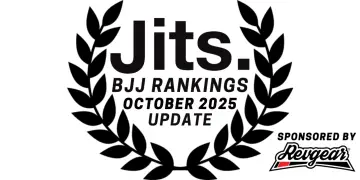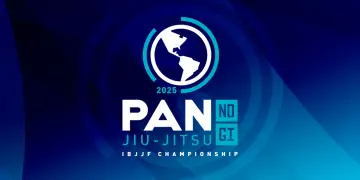It can be tough to understand the ideal tactics specific ruleset in BJJ, and EBI rules are no exception to that. That’s why we’ve put together a series of articles breaking down the best way to approach different rulesets, and this edition focuses on EBI rules. This particular ruleset was created by American BJJ legend Eddie Bravo, in an attempt to create a more exciting product. Bravo reasoned that submissions were the best part of Jiu-Jitsu so he attempted to create a ruleset that incentivises them, while also not incentivising any specific sequences or positions through the use of points.
For more of our BJJ guides that explain the different aspects of the sport, click here.
What Are The Best Tactics For EBI Rules?
EBI rules are a relatively simple format, but the tactics used can greatly affect the outcome of the match. It’s potentially the easiest ruleset for worse competitors to beat better opponents, and the use of EBI overtime is what makes that possible. EBI rules matches are submission-only during the regulation time period and if that ends without a submission, it goes to EBI overtime. This is where each competitor gets up to three two-minute rounds to submit their opponent starting from their back or in an armbar, while they attempt to escape and stop the clock. The fastest submission wins, or in the case of no submission then the most ride-time wins.
Are You Better Or Worse Than Your Opponent?
Preparing for any match requires an athlete to be completely honest with themselves about both their own skillset and their opponent’s skillset. While everyone must believe that they can win, the correct way to earn that belief is through proper preparation rather than simply being misguided. EBI rules can be even tougher to prepare for mentally than most other formats, because understanding the ideal tactics requires a competitor to first determine who is the actual better grappler. Thats because the first part of an EBI match is the submission-only regulation period, where the better grappler should theoretically be able to win.
Because the EBI overtime period is a huge equalizer in skill level, the better or worse grapplers should have different approaches to the regulation period. If you are actually better than your opponent then you should always strive to finish the match before EBI overtime. There’s no reason to stall or disengage because there are no points in play, which makes hunting for the finish aggressively the ideal strategy. The worse grappler however will want to make it to EBI overtime in order to give themselves a chance of winning. This means disengaging and breaking up the action at all costs, while also attempting to be busy enough to avoid falling foul of the ‘get down’ rule.
EBI Rules Overtime Tactics
Reaching EBI overtime means one of two things. You have either succeeded and now have a good chance to beat a better grappler or you have failed and are now in a very tough situation. Either way, this is portion of an EBI rules match is where everyone should be making use of the same tactics to maximise the chances of victory. The most important thing is first to choose the best position and although there’s a little variance, most people will take the same path. The goal in the first offensive round of overtime should be to maximise the ride-time that you can score, building yourself a comfortable lead.
To that end, the ideal choice is almost always back control. This gives you the best chance of maintaining control, with only one exception. If you are a competitor who is extremely skilled at controlling from the spiderweb armbar position then there’s nothing wrong with choosing that instead. The goal should still be the same though and even if you are confident in your ability to finish from there, ride-time is what you should be aiming for. Obviously getting a submission win early is great, but hunting that aggressively and ending up losing the position as a result can be disastrous.
In the first defensive round, a quick escape is obviously preferable but this should never come at the risk of being submitted. Make a defensively sound escape, as quickly as you can. The ideal result of these tactics in the first combined round of EBI rules overtime should be to reach the maximum ride-time and clinching an early escape. A submission win may come, but that isn’t the goal yet. By building up a healthy lead going into the second round, it’s an easy way to put your opponent under a ton of mental pressure and increase your chances of winning.
The Second Overtime Round And Beyond
This is where things start to diverge into multiple paths, depending on how the first overtime round has gone. If your tactics worked then it’s time to repeat them in the second round in order to extend the ride-time lead to an insurmountable number. An advantage of over 2 minutes going into the third round is impossible to overcome without a submission. You can also start to be a little more liberal with the submission attempts, and even more aggressive in the final round if you’ve built up a good lead. Quick yet safe escapes are the goal in the defensive rounds, provided the approach is still working in the offensive rounds.
If you haven’t achieved the goals set out in these tactics during the first round EBI overtime rules then it’s not time to panic yet. Sticking to the approach in the second round and attempting to pull level or ahead leading into the third round is the best course of action. If the opponent gets an even bigger lead after the second round then this is where the tactics must change. The best course of action from there is to aggressively hunt the finish, choosing whichever of the two positions you personally are better at finishing from. There’s nothing wrong with choosing either back control or spiderweb armbar, but the goal now is to get the submission and secure the win.
What If They Get The Submission In Overtime?
If you are attacking first and your opponent submits you during your defensive round, there’s nothing that you can do at that point. EBI rules don’t allow someone to continue to the next round if they were submitted and failed to land a submission during this round, so the match is over. The only time that you are submitted and still have a chance to win is if your opponent is attacking first. That gives you just one round to get the submission and you only have however much time your opponent has taken to submit you, making a comeback from this point incredibly unlikely.
Unlikely does not mean impossible though, and several competitors have managed to come from behind and submit their opponent quicker than they were submitted. The best tactics to win under EBI rules at this point depends on a few different factors. You have to weigh up which position you are better at attacking from, how much time you have, and which position your opponent has shown better defense from so far. It’s a tough decision to make in the heat of the moment, but it’s absolutely vital that you go into this final round confident that you can get the submission in the time remaining.
How Do You Prepare For EBI Rules In Training?
While the tactics used in an EBI rules match are of the utmost importance, a lot of work is done in the training room beforehand too. The best way to prepare for an EBI rules match is to do a lot of positional sparring under the overtime conditions. EBI absolute champion Ryan Aitken does these rounds before regular sparring, although other competitors might disagree with this. Them being done in a high volume is the main thing regardless, but a certain amount of training should also focus on which approach you need to take to the regulation time period as well.
If you are the better grappler and are trying to finish the match before you reach overtime then preparing for the worst is still necessary, but your regular sparring should focus on your regulation period goals. Hunt the submission finish in every sparring round aggressively from start to finish, and don’t worry about any traditional point-scoring either. For the worse grappler, these rounds should be spent developing guard retention and the ability to return to standing when in a bad position inside someone else’s guard. Positional sparring rounds focused on both early and late stage submission defense is also going to be very beneficial if things start to go poorly.
For more of our opinion pieces on various topics, visit our opinion piece archives.












